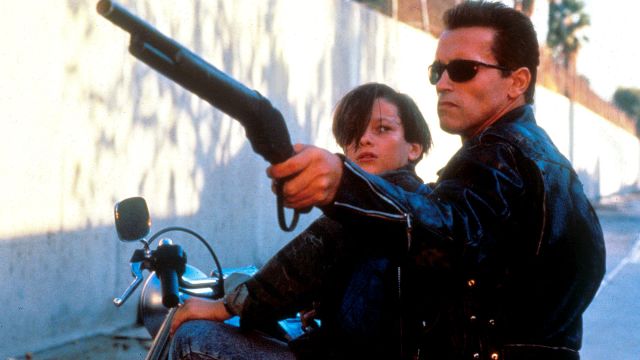Terminator 2: Judgment Day (1991) 
“This time there are two”

Director: James Cameron
Cast: Arnold Schwarzenegger, Linda Hamilton, Edward Furlong
Synopsis: A cyborg, identical to the one who failed to kill Sarah Connor, must now protect her ten-year-old son, John, from a more advanced cyborg, made out of liquid metal.
In 1984, when Arnold Schwarzenegger appeared in the first Terminator movie, he was still in the process of building a movie career which would see him reach the top of the A-List in the late 1980s. In the first film he was the bad guy, an implacable machine programmed to destroy with very few lines to speak — which is just as well, because, whatever you might think of Schwarzenegger’s acting talent overall, he was a much worse actor in 1984 than he was in 1991. Schwarzenegger was box-office gold by the time Terminator 2: Judgment Day was made, so it was impossible for him to play the villain. The Terminator had to be a huggable, protective father figure — and so, writer-director James Cameron undertook to write probably the most radical reversal of a character’s personality ever seen in the movies: from absolute evil to absolute good.
The mantle of absolute evil was agilely assumed by Robert Patrick for the sequel. He plays the T1000, a new, improved terminator sent back from the future by the machines that have overrun the world to kill 10-year-old John Connor (Edward Furlong), who will one day become the leader of a troublesome resistance movement. To protect young Connor, the resistance send back their own terminator (Arnie), reprogrammed to fight on the side of good. Young John lives with foster parents while his mother Sarah (Linda Hamilton) has her face licked by overweight guards in a nearby mental institute, where her stubborn insistence that machines will one day take over the world ensure she remains a long-term resident. Fortunately for John, Arnie gets to him before the T1000 and, after he helps to reunite mother and son, the three of them begin a desperate search for the surviving microchip from the original Terminator that will precipitate the rise of the machines.
With a budget fifteen times greater than the original movie, Terminator 2: Judgment Day took the action movie to new heights with a series of spectacular sequences combined with cutting edge special effects which are maybe just starting to show their age. James Cameron has the happy knack of writing reasonably intelligent scripts while simultaneously catering to action fans who just want to see high-speed chases and big explosions, and fashions an involved storyline which, as with most time-travel stories, doesn’t quite hold up to close inspection. For example, the fact that the terminator continues to exist after John throws the original chip into a vat of molten lave should immediately alert them to the fact that they haven’t succeeded in altering the course of the future.
But movies like Terminator 2: Judgment Day aren’t about dotting every I and crossing every T — they’re about delivering a heart=pounding, visceral rollercoaster-ride of slick action and breathless pacing. And for a sequel it has very little of that more-of-the-same feeling, thanks largely to the creation of T-1000, the epitome of clean-cut goodness gone awry in his impeccably pressed police uniform, and with even his tightly cut hair seeming to possess a kind of metallic sheen. The T-1000 is an improvement over The Terminator, constructed from a liquid metal which enables it to instantly reform whenever bullets pass through it (which they often do) or it is blown apart. Perhaps if the film were made today it wouldn’t be so violent, but after a while its regular inclusion desensitises the viewer, especially given T-1000’s ability to emerge unscathed from even the most fatal of incidents.
As a side-note, it’s kind of interesting the way that reality is slowly catching up with Cameron’s speculative SF story. At the time of writing, philosophy professor Huw Price, Skype founder Jaan Tallinn, and President of the Royal Society Lord Martin Rees have just formed the Centre for the Study of Existential Risk (CSER), a body to address concerns arising over the threat to the human race posed by the ever-increasing rate of technological advances. “At some point, this century or next, we may well be facing one of the major shifts in human history — perhaps even cosmic history — when intelligence escapes the constraints of biology,” wrote Price. “Nature didn’t anticipate us, and we in our turn shouldn’t take AGI (artificial general intelligence) for granted. We need to take seriously the possibility that there might be a ‘Pandora’s box’ moment with AGI that, if missed, could be disastrous.”
(Reviewed 9th August 2012)
httpv://www.youtube.com/watch?v=eajuMYNYtuY
